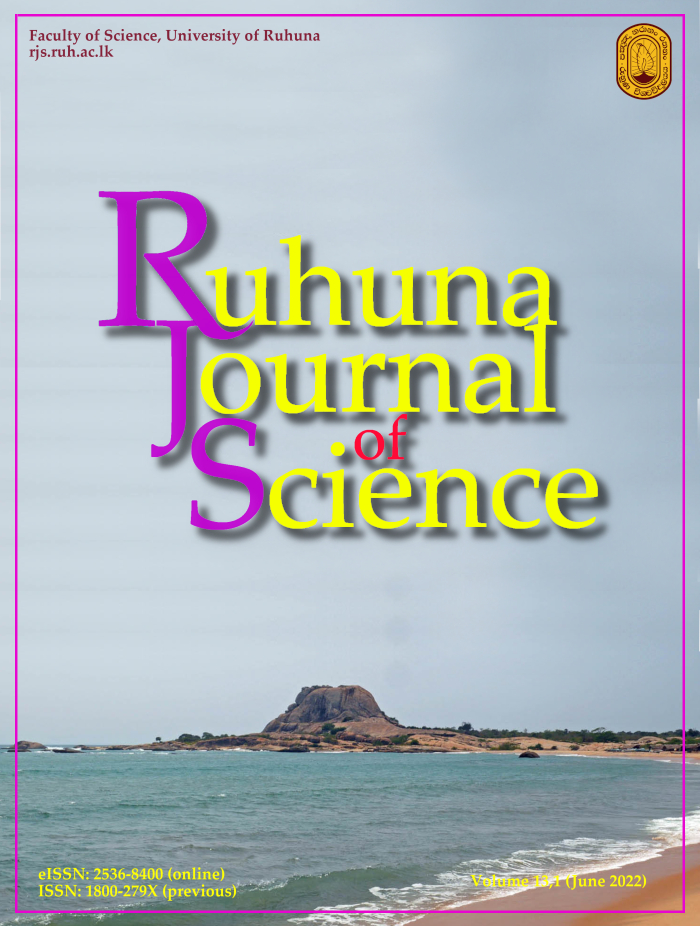Trends in appliance usage and electricity consumption in households: A case study in Hambantota District, Sri Lanka
Abstract
The study aimed to develop interrelationships among electricity consumption, the plan area of the house, period of construction and appliance availability in Hambantota district in Sri Lanka. For this survey, the data was collected from 385 houses by means of door-to-door visits. Electricity consumption increases with the increase in the number of family members and the plan area of a house, but it is reduced with the age of the house. The availability of air conditioner, refrigerator, electric kettle, electric iron, vacuum cleaner, laptop computer, and incandescent bulbs significantly influences the electricity consumption in a particular housing unit. An increasing trend in energy demand for thermal comfort was observed in the region. Houses built after 2008 use an average of 100 kWh of electricity per month, which is a 30 kWh increase over older houses (built within or before 2008) in the area, resulting in an increase in energy demand in the area. The results of this study are a valuable reference in policymaking related to market availability of appliances, deciding electricity tariffs, and identifying potential ways to improve energy use efficiency in the domestic sector. Keywords: Appliances, domestic consumption, electricity demand, tropical climate, thermal comfort.References
Cabeza LF, Ãœrge-Vorsatz D, Palacios A, Ãœrge D, Serrano S, Barreneche C. 2018. Trends in penetration and ownership of household appliances. Renewable and Sustainable Energy Reviews 82:4044-4059.
CEB. Retrieved from https://ceb.lk/electricity-generated/en (accessed 04-03-2021).
CEB. 2016. CEB statistical report- 2016. Ceylon Electricity Board, Sri Lanka.
Department of Census and Statistics. 2016. Household Income and Expenditure Survey – 2016. Department of Census and Statistics, Sri Lanka.
Department of Census and Statistics. 2012. Census of Population and Housing Sri Lanka – 2012. Department of Census and Statistics, Sri Lanka.
Gouveia JP, Seixas J. 2016. Unraveling electricity consumption profiles in households through clusters: Combining smart meters and door-to-door surveys. Energy and Buildings 116:666–676.
Huebner G, Shipworth D, Hamilton I, Chalabi Z, Oreszczyn T. 2016. Understanding electricity consumption: A comparative contribution of building factors, socio-demographics, appliances, behaviours and attitudes. Applied Energy 177:692–702.
Israel GD. 2003. Determining Sample Size, Institute for food and agricultural science, University of Florida, USA.
Jones RV, Fuertes A, Lomas RV. 2015. The socio-economic, dwelling and appliance related factors affecting electricity consumption in domestic buildings. Renewable and Sustainable Energy Reviews 43:901–917.
Le VT, Pitts A. 2019. A survey on electrical appliance use and energy consumption in Vietnamese households: Case study of Tuy Hoa city, Energy & Buildings 197:229–241.
Leahy E, Lyons S. 2010. Energy use and appliance ownership in Ireland. Energy Policy 38 (8): 4265–4279.
McNeil MA, Letschert VE. 2010. Modeling diffusion of electrical appliances in the residential sector. Energy and Buildings 42:783–790.
Ndiaye V, Gabriel K. 2011. Principal component analysis of the electricity consumption in residential dwellings. Energy and Buildings 43:446–453.
ODYSSEE-MURE. 2021. ODYSSEE database. Sectoral profile - Households. Retrieved from https://www.odyssee-mure.eu/publications/efficiency-by-sector/households/electricity-consumption-dwelling.html (accessed 04-03-2021).
Rao ND, Ummel K. 2017. White goods for white people? Drivers of electric appliance growth in emerging economies. Energy Research & Social Science 27:106–116.
Ürge-Vorsatz D, Cabeza LF, Serrano S, Barreneche C. 2015. Heating and cooling energy trends and drivers in buildings. Renewable and Sustainable Energy Reviews 41:85–98.
Downloads
Published
Issue
Section
License
From Volume 7 (2016) onwards, all articles published in Ruhuna Journal of Science are Open Access articles published under the Creative Commons CC BY-NC 4.0 International License. This License permits use, distribution and reproduction in any medium, provided the original work is properly cited and is not used for commercial purposes.
Copyright on any research article published in RJS is retained by the respective author(s).
Authors who publish with this journal agree to the following terms:
a) Authors retain copyright and grant the journal right of first publication with the work simultaneously licensed under a Creative Commons Attribution License CC-BY-NC 4.0 International, that allows others to share the work with an acknowledgement of the work's authorship and initial publication in this journal.
b) Authors are able to enter into separate, additional contractual arrangements for the non-exclusive distribution of the journal's published version of the work (e.g., post it to an institutional repository or publish it in a book), with an acknowledgement of its initial publication in this journal.
c) Authors are permitted and encouraged to post their work online (e.g., in institutional repositories or on their website) prior to and during the submission process, as it can lead to productive exchanges, as well as earlier and greater citation of published work (See The Effect of Open Access).

